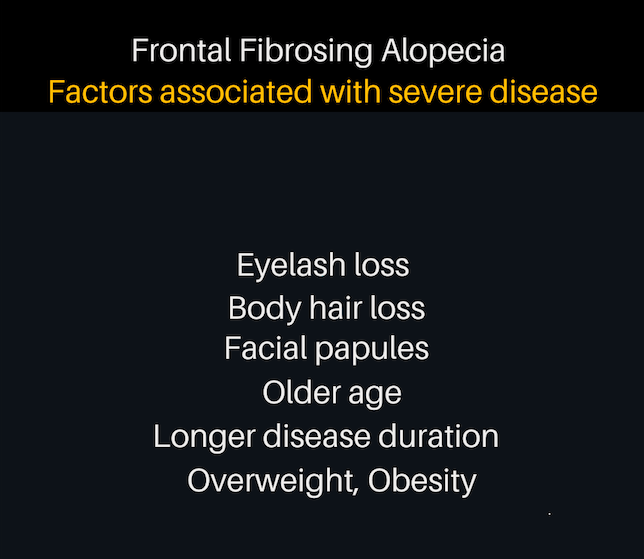Frontal Fibrosing Alopecia: Top Five Factors Associated with Severe Disease
Top Five Factors Associated with Severe Disease in FFA
A nice study was recently published by O.M. Moreno-Arrones and colleagues looking at the risk factors for severe disease in patients with frontal fibrosing alopecia (FFA). I found that this study had a number of interesting findings.
First, the 2/3 of patients in their study had mild disease and 1/3 had severe disease. This is a nice reminder for us all that it’s really not an insignicant number who present to the clinic with severe disease. Second, the authors did a really nice job comparing variables associated with having SEVERE disease with variables associated with having MILD disease. There were five main factors that stood out as being associated with severe disease:
1. Age of patient (older age associated with more severe disease)
2. Age when diagnosed (older age at diagnosis associated with more severe disease)
3. Years they have had the disease (longer duration associated with more severe disease)
4. BMI (higher body mass associated with more severe disease)
5. Lower academic level
Several factors are thought to be associated with more severe disease in patients with frontal fibrosing alopecia.
Third, I was interested to see that 70-80 % of patients used facial sunscreens and about 90 % used facial moisturizers. However, there was no difference between those with severe disease and those with mild disease in terms of use of these products. One of the current hypotheses is that facial moisturizer and sunscreen ingredients are important triggers of FFA.
Fourth, it’s very clear that FFA is a hormonal disease and this study supports this notion as well. A proportion of women with FFA have early menopause and some have histories of hysterectomies. Body mass stands out as also being somewhat of a risk factor – women with higher body mass were found to have more severe disease. The significance of this is not clear but certainly one wonders what exactly the significance of this is given that higher body mass if often associated with higher estrogen levels (and lower estrogen is proposed to have some relevance). Clearly we have more to learn!
REFERENCE
Moreno-Arrones OM et al. Factors influencing frontal fibrosing alopecia severity: a multicentre cross-sectional study.J Eur Acad Dermatol Venereol. 2019 Mar 21. doi: 10.1111/jdv.15590.
This article was written by Dr. Jeff Donovan, a Canadian and US board certified dermatologist specializing exclusively in hair loss.

